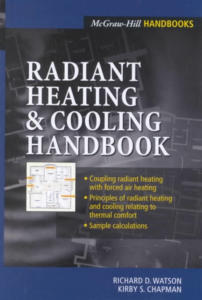Radiant Heating and Cooling Handbook
Radiant Heating and Cooling Handbook
The Radiant Heating and Cooling Handbook the first and only professional guide to radiant heating and cooling system design Packed with tools that make the work of HVAC systems designers, engineers, and technicians go more smoothly and easily, this expert handbook features all the help you need to create the newest and most popular and efficient systems for industrial, commercial, and residential applications. Radiant Heating & Cooling Handbook features:
- Everything you need to size, design, and position radiant heating & cooling equipment efficiently and effectively in any environment
- Essential information relating heating and cooling theory to the principles of thermal comfort
- Equations, strategies, and analyses to help you set parameters from sizing and cost to human comfortability the only complete source of hands-on radiant heating & cooling system design, with problem-solving guidance from leading experts.
You can download Plumber’s and Pipe Fitter’s Calculations Manual
Content
- EXAMPLES OF RADIANT SYSTEMS
![Radiant Heating and Cooling Handbook]()
- ADVANTAGES OF USING RADIANT SYSTEMS
- HOW TO USE THIS BOOK
- FUNDAMENTALS OF HEAT TRANSFER AND THERMODYNAMICS
- THE ENERGY BALANCE
- CONDUCTION AND CONVECTION HEAT TRANSFER
- RADIATION HEAT TRANSFER
- MULTIMODAL HEAT TRANSFER
- PSYCHROMETRICS AND MIXTURES
- FLUID MECHANICS
- THERMAL COMFORT
- THE BUILDING COMFORT ANALYSIS PROGRAM METHODOLOGY
- RADIANT HEATING SYSTEMS
- ELECTRIC RADIANT HEATING PANELS
- HIGH-TEMPERATURE HEATERS
- RADIANT HYDRONIC HEATING SYSTEMS
- CASE STUDIES
Case study information is frequently requested, but seldom fully understood in terms of relating the conditions under which it was conducted to the actual results reported. In fact, the real need is for studies with populations that are of sufficient size to provide
a statistically representative sample of actual field performance of heating or cooling systems “as used” in buildings “as built.” Unfortunately, the costs, politics of energy source, equipment involved, and proponents of the study make it almost impossible for the major consensus research-funding agencies and organizations to set up and conduct large-scale comparative heating or cooling system performance studies.
Download
1st Link Here
2nd Link Here


Comments are closed.